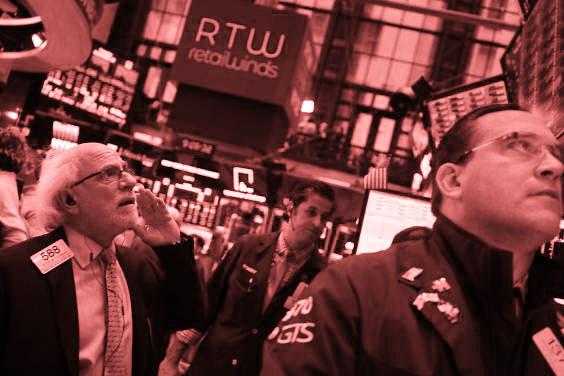Something troubling is happening in American bond markets.
Traders are talking about an “inverted yield curve”, which some insist is a harbinger of recession.
But what is a yield curve? Does it really mean a recession is likely? How concerned should we really be?
What are bond yields?
They are, effectively, the rates of annual interest paid out to investors by bonds.
The yield on short-term US government bonds is normally well below the yield on equivalent long-term bonds, reflecting the simple fact that people will generally want a larger return if they are going to lock their cash away for longer.
This results in an upward sloping “curve”, with bond yields gently rising as the redemption date of the bond stretches into the future.
So what’s an inversion?
Sometimes the yield on short-term bonds rises, bringing short-term borrowing rates close to long-term rates, thus flattening the profile of the overall borrowing yield curve.
And sometimes the yield on short-term bonds can even go higher than that of long-term bonds.
This isn’t just a flattening, but an “inversion”.
Is that happening now?
Not quite, but it’s getting close.
The two bonds that traders and analysts conventionally use to test for an inversion is the gap between the 10-year US Treasury bond and the 2-year bond.
That gap is down to just 10 basis points (0.1 percentage points), having been falling steadily since the end of 2016.
So why does it matter?
Historically, major economic downturns in the US, but also in certain other advanced economies, have been preceded (by around 6 to 24 months) by an inversion of the yield curve.
Research by John Williams, the new President of the New York Federal Reserve Bank, has shown that the yield curve has been a better predictor of recessions than professional forecasters.
A recession in the US, the planet’s biggest economy, would inevitably hit the rest of the world, including the UK.
Incidentally, in the UK the 10-year/2-year government bond yield gap is still around 70 basis points, though this too has fallen over the past two years.
But why would an inversion signal a recession?
The general argument is that traders expect the economy to be weaker further out than it is today and for the central bank to be compelled to cut interest rates at some point to support growth.
So traders bid the yields on longer-term bonds lower than shorter ones in anticipation of that monetary policy shift (rate cuts mean higher bond prices which, in turn, mean lower bond yields).
Yet, if this is what’s going on, there’s no clear reason why this cooling should mean an outright recession rather than simply a growth slowdown.
The fact that a recession has tended to follow inversions has merely been the historical pattern.
So should we expect a recession for the US now?
The US economy is not showing any of the conventional signs of dangerous overheating that could result in a slump.
Unemployment is very low, at around 4 per cent, but inflation still seems reasonably quiescent at around 2.5 per cent.
Core inflation, which strips out volatile food and energy, is only 2.15 per cent.
Wages are rising at an annual rate of 3 per cent, below the levels seen before the global financial crisis.
Some see signs of excessive borrowing among US households, but, again, leverage is not growing at anything like the rates seen before 2008.
Any other contrary arguments?
Major central banks around the world have spent trillions of dollars, euros, pounds and yen in buying up long-dated sovereign bonds over the past decade.
This, the argument goes, has distorted long-term bond yields, meaning that one cannot, in the current circumstances, infer very much useful information from the shape of the curve.
The current chair of the US central bank, Jerome Powell, has explicitly said he does not believe the flattening curve, and the possibility of inversion, signals an imminent downturn.
Further, the predictor is not 100 per cent accurate. The Treasury curve flattened dramatically in the mid-1990s, during the Bill Clinton-boom, without leading to a US recession.
The equivalent curve in the UK and Japan has sent misleading signals too in recent decades, missing recessions as well as sending out false positives.
So we can relax?
Not quite. Central bankers are certainly not omniscient about such matters.
Back in 2006 one of Mr Powell’s predecessor, Ben Bernanke, argued firmly that a flattening US yield curve did not presage a recession. And there was a lot of talk then too about how the inverted yield curve was a broken indicator.
When the crash came, not long after, it was, of course, the biggest since the Great Depression.
Where does that leave us? While it would be foolish to ignore the yield curve given its empirically proven predictive power, it would also be a mistake to regard it as some kind of oracle.
Subscribe to Independent Premium to bookmark this article
Want to bookmark your favourite articles and stories to read or reference later? Start your Independent Premium subscription today.


Join our commenting forum
Join thought-provoking conversations, follow other Independent readers and see their replies